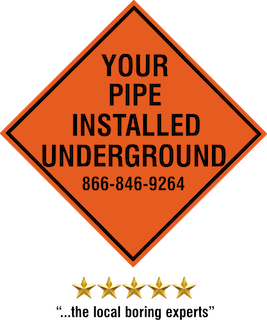Directional Boring
What is Directional Boring?
Directional boring, commonly called horizontal directional drilling or HDD, is a steerable trenchless method of installing underground pipes, conduits and cables in a shallow arc along a prescribed bore path by using a surface launched drilling rig, with minimal impact on the surrounding area.
Directional Boring, also known as Horizontal Directional Drilling (HDD) is the most efficient method known for installing utilities underground.
Directional boring eliminates the need for trenching or open cutting roadways and other hard surfaces, reducing interruption to traffic and disturbance to landscape as well as existing surfaces.
The trenchless drilling process is used for installing power and telecommunications cable conduits, water lines, sewer lines, gas lines, oil lines, irrigation lines, product pipelines and casings used for environmental remediation.
HDD is used to cross rivers, roadways, congested areas, environmentally sensitive areas and any area where other methods are more expensive or aren’t feasible. Use of the directional boring method is growing rapidly and is expected to increase for the foreseeable future.
Directional boring is used in place of other drilling techniques for the following reasons:
Deeper installation possible
Directional and curved capabilities
Less traffic disruption
Longer installation distances possible
Lower costs
No access pit required
Safer for the environment
Shorter project completion times
Arkansas Boring Contractor Directional Bore | Boring Pilot Hole
Arkansas Boring Contractor Directional Bore | Boring Pilot Hole
Pilot Bore:
A pilot (bore) hole is a small hole drilled as a guide for the drilling of a larger hole.
The action of creating the first (usually steerable) pass of any directional boring process, which later requires back reaming or similar bore hole enlargement.
The process begins when a directional bore machine pushes a bore head connected to hollow pipe into the ground at an angle. As each joint of drill pipe is pushed into the ground a new joint of pipe is added behind and torqued until it reaches its predefined destination and exit point.
Arkansas Boring Contractor Directional Bores | Pipe Reaming
Arkansas Boring Contractor Directional Bores | Pipe Reaming
Back-Reaming: Upon reaching the destination exit point, the drill bit is detached and the end of the drill pipe is attached to a reamer or hole opener (for rock) if the borehole must be enlarged. The reamer is pulled back while rotating the drill pipe with as many consecutive passes as needed to enlarge the hole. Drill pipe is added behind the reamer or hole opener so that there is always drill pipe in the borehole.Arkansas Boring Contractor Directional Boring | Pipe Pull-Back
Arkansas Boring Contractor Directional Boring | Pipe Pull-Back
Pull Back:
Pull-back is the part of the horizontal directional drilling process in which the drill string is withdrawn through the bore back to the entry pit, usually installing the product pipe at the same time.
The success of a horizontal directional drilling (HDD) drill is largely dependent on the success of the pull back operation, when the product pipe is installed in the created borehole. The cost of damaging pipeline and the costs for additional measures during and after the pull back operation can be considerable if not managed properly.
Some of the problems which might occur during a pull back operation vary from uncompleted pull back operations to slight coating damages.
When the bore hole is approximately 25% larger than the product pipe to be installed, the end of the product pipe is connected to a reamer or barrel reamer and then a swivel attached to the pipe to be installed and pullback commences.


